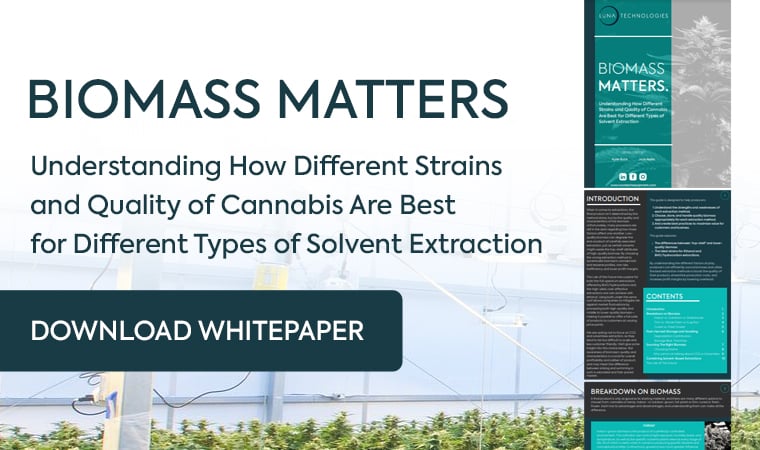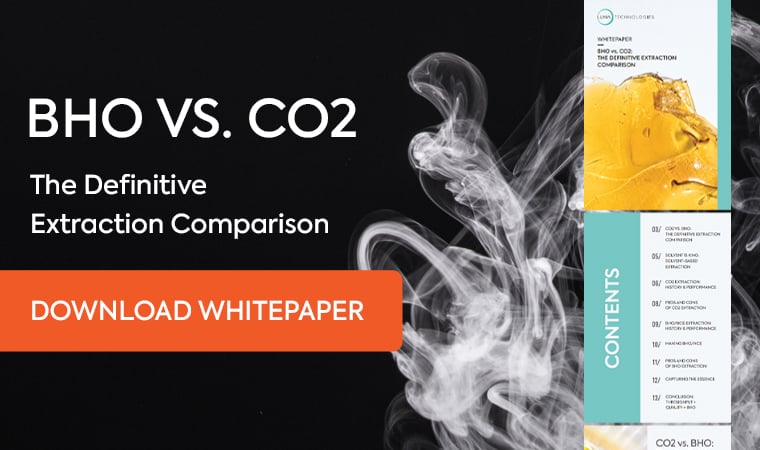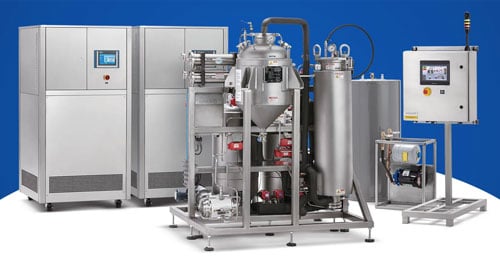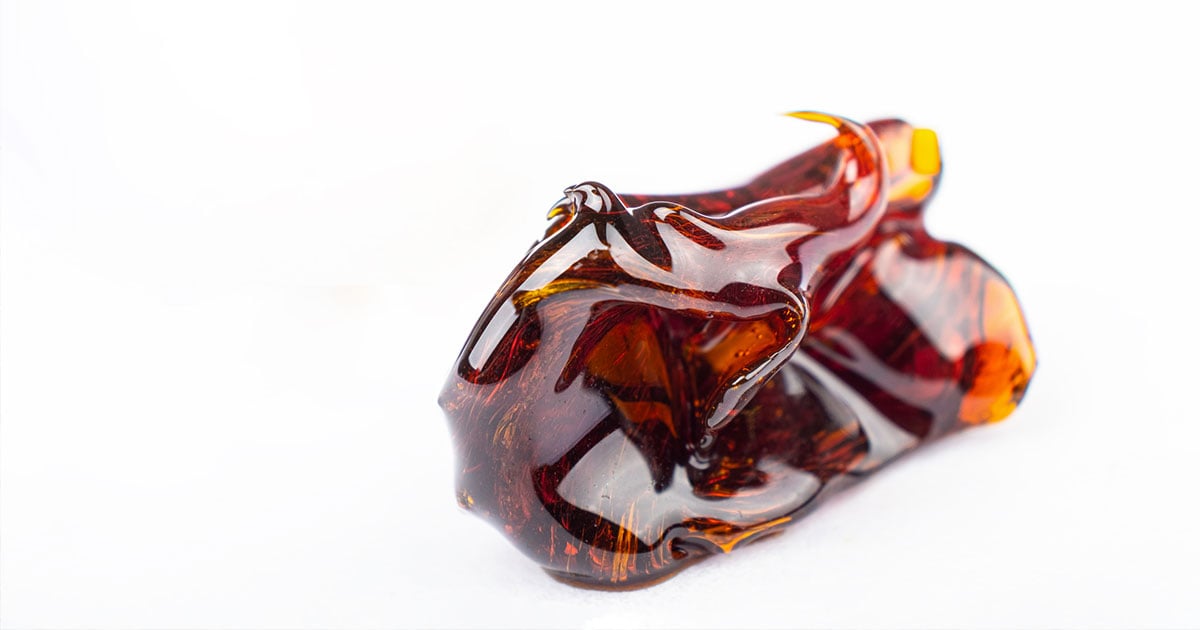
Butane hash oil (BHO) extractions are one of the most efficient methods of producing cannabis concentrates. While this extraction method can produce a high-terpene full-spectrum extract better than any other solvent, the SOPs used can elevate the process to an art form.
Everything from cheap equipment to inexperienced operators to low-quality material can result in a lower-grade product than you expected. If you are tired of producing low-quality oil or just want to beat the learning curve, check out our top BHO extraction tips from the pros.
1. Hire the Right Team
The extraction technician position is one of the most coveted in the industry. This position must have attention to detail, prior lab experience, and experience working with botanical extraction equipment. They must be able to work with closed-loop extractors and be aware of the job hazards that come with working with flammable solvents.
While it may be tempting to save money on payroll and direct it to your profits, making the investment for an experienced technician can potentially save you money, time, and headaches in the long run when you want to scale up or when you have a problem with the equipment and you have any person who can troubleshoot it.
The right extraction team understands the science behind the extraction process, especially the use of hazardous chemicals and their effects on cannabinoids, terpenes, and other active compounds. In addition, the team members should understand the importance of being compliant with state and local regulations.
In addition to hiring the right cannabis extraction technician, you need a team of business experts such as accountants, attorneys, real estate agents, insurance agents, security specialists, and more to guide you through the unique regulations in the cannabis industry.
2. Research Equipment Manufacturers
There are more cannabis extraction equipment manufacturers than ever with the expansion of legalization across the country and the world. When buying extraction equipment, look for case studies of companies that have had success with the equipment. Read as many reviews as possible to see how other customers have liked their equipment.
LinkedIn is an especially rich source of industry insights if you have connections with industry leaders. Seeking out advice on equipment recommendations and manufacturers from professionals on LinkedIn can yield good results.
Better yet, reach out to the manufacturers and ask specific questions about the equipment’s throughput, features, and other considerations that relate to your business. Let them know what products you want to create so they can help you find a solution that meets your needs.
3. Use Peer-Reviewed Equipment
A peer-review by a state-certified mechanical engineer is used to prove that the system is safe to use for its intended purpose, which is hydrocarbon extraction. Nowadays, you can choose from a handful of engineering firms that provide peer-review services for equipment in the cannabis extraction market.
Since more and more states are legalizing cannabis for medical and recreational use, you want equipment that is peer reviewed in the state you plan to operate in. Consider your expansion plans and if your equipment is reviewed for the states you plan to expand to. The best equipment is peer-reviewed for every legal cannabis state.
In addition to looking for peer-reviewed equipment, you should consider a manufacturer's customer support and replacement lead times. When you inevitably run into an issue with your system, you want a manufacturer specialist ready to help to avoid long production delays.
4. Evaluate Your Business Goals
Before buying or investing in new BHO extraction equipment, you need to have a clear understanding of your desired throughput and business goals. How much plant material will you be processing daily and monthly? Estimate your desired throughput and consider the ability to scale your operations with the equipment you plan to purchase.
Understand the type of product you want to create and sell. If you know what your product line and expansion goals are, you can find a closed-loop system that can meet all of your needs and cover the product niches you want to cover. Popular cannabis products made by cannabis processors include:
- Extracts
- Edibles
- Tinctures
- Vape cartridges
- Topicals
- Capsules
- Transdermal patches
- Beverages
5. Create a Compatible System and Workflow
Cannabis processors must ensure that every aspect of their workflow, including their equipment, is compatible to reduce the bottlenecks that can occur during primary extraction and post processing activities.
Manufacturers must ensure that the throughput of the closed-loop extraction system matches the capacity of the recovery system. If the capacity does not match, then there are delays in production and machines that are not being put to good use.
In addition to matching the equipment capacity, consider the run to run time between each phase of the production process. How much time does it take to clean, load and unload as well as perform repairs on your equipment? Is there one part of your operation that is slowing down production?
6. Consider Automation
Automation in your extraction systems can significantly reduce your labor costs and speed up your run times. Automation not only saves you on the cost of labor but also creates a more seamless workflow, especially if every phase of the production process is automated including extraction, decarboxylation, and solvent recovery.
When a system is fully automated, operators do not have to perform a host of time-consuming tasks such as carrying the biomass and crude extract from one stage of the workflow to the other. Instead, the material can be pumped through from one phase to another, which can also reduce product loss that can occur when using separate containers.
In addition, automation can potentially reduce the risk of repetitive use injuries and workers compensation caused by unnecessary manual labor. When a machine is doing most of the heavy lifting in your operations, the operators can focus on improving the process elsewhere without having to do as much manual work.
7. Inspect for Leaks
Over time, the joints and seals in your state-of-the-art equipment can wear down causing leaks of the solvent and material throughout the closed-loop system. Some BHO processors check for leaks in the system by running a mixture of water and soap inside instead of the solvent used during extractions.
During this simple check for leaks, operators can pump the water and soap solution through the system and isolate any areas that develop bubbles and leaks along the way. By taking the time to check where the leaks are, operators can fix them right away and prevent a dangerous situation
Performing regular cleaning and maintenance of your equipment can ensure you do not have any residual solvent leaking through the system or oxygen getting into your pressurized system when you do not want it to. In the case there is a solvent leak, proper ventilation can reduce the risk of a fire or an explosion.
Fire requires oxygen, fuel, and the spark to ignite it. If you have any leaks in your BHO system, the slow release of gas and oil can increase your risk of injury. In addition, equipment that suffers from excessive wear and tear can cause long production delays and low yields.
8. Focus on Ventilation
A BHO facility requires an efficient exhaust system to significantly reduce the concentration of butane gases at explosive levels. Generally, the gases should be contained in their storage containers or within a closed loop system. In the event that there is a leak or the gas cannot be contained, ventilation can provide fresh air flow to reduce the risk of fire or explosion.
In addition to an efficient exhaust system in your facility, a gas detection system in your processing room ensures that operators become aware of unsafe levels of flammable gas with an audible and/or visual alarm. That gas detection system works in conjunction with a ventilation system that can kick on as soon as flammable levels are detected.
9. Ensure Electrical Equipment Is Safe to Use
A butane extraction lab must contain electrical components and connections that are classified as safe to use in the C1D1 environment. Electrical components include everything inside such as security systems, gas detection systems, gas compressors, and electrical plugs.
By ensuring that all the electrical equipment used in the processing room is listed as safe for use in these environments, you will reduce the risk of fire or explosion. Removing these unsafe devices ensures you do not provide the spark necessary for ignition of flammable gases.
10. Follow Best Storage Practices of Solvents
When working with butane and propane solvents for extraction, storing them properly is one of the most important elements of reducing the risk of leaks and explosions.Butane and propane both have a relatively high risk of igniting.
Ideally, all solvent canisters should be kept away from any heat sources such as sunlight, flames, oxidizers, electrical outlets and other direct heat sources. Store them in a cool and dry location. Make sure you have good ventilation in the storage space to ensure the gases do not build up in the event of a leak.
11. Source High-Quality Biomass
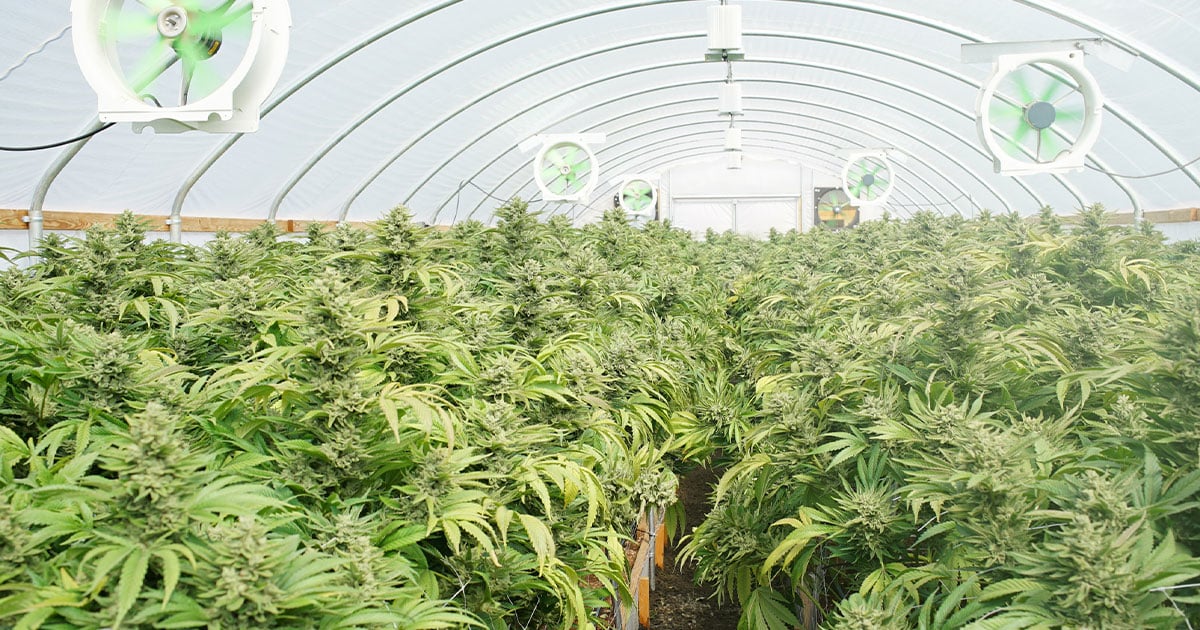
Sourcing the right cannabis strains for your desired product is critical to obtaining the characteristics you want such as terpene content, flavors, consistency, and potency. The type of strain you use and its quality may vary depending on the type of product you are creating. Distillate can use lower quality trim while live resin can use fresh-frozen cannabis.
Look at the trichomes
For the highest quality material, look for dense and mature trichomes on the buds or trim. Ideally, the higher the quality of starting biomass material, the better quality end the product you will produce. Use a magnifying glass to take a closer look at the heads of the trichomes and ensure they are still intact.
Test your products
Sending a representative sample from the plant material to an analytical lab before the extraction is done can determine whether the biomass is safe to use or not. Analytical labs can test for potency and purity of the product. While lab testing can increase production costs, it can pay off by creating a reputation of excellence.
12. Use Cold Extraction Temperatures
BHO extractions perform better in colder temperatures. Why? Together, water and butane have a relatively low solubility.
Freezing the plant material can trap the moisture and solidify it as ice. The frozen plant material reduces the chance of water blending with the butane solvent. When water is present, the concentration of water-soluble compounds such as chlorophyll in the end product can increase. Chlorophyll can make your extract look darker and have a harsher hit.
Pro tip: In addition to using frozen plant material, in line desiccant dryers can remove any water and oil vapor in the system due to the gases.
13. Consider the Plant Material Consistency
How fine should your biomass consistency be for BO extraction? Grinding the material too fine or too coarse can affect the quality including flavor and aroma of the end product. A fine grind can produce a harsh, grassy, aroma and flavor. When the material is finely ground, the cell walls of the plant biomass are broken, allowing the solvent to extract more of these undesirable compounds alongside the cannabinoids and terpenoids.
If it is not grinded finally enough, you may make a decent product but you may not be taking advantage of the space in your material column. Generally, processors grind the cannabis the same consistency needed to roll a joint. Keep in mind, due to hydrocarbon extraction’s efficiency, getting a fine consistency is not as important and can even be done with allflower nugs, also known as a nug run.
14. Determine the Packing Density
How densely packed should you be packing your plant material in your material container? In theory, packing it as dense as possible would increase throughput of the extraction process since you are maximizing the space inside the material container. However, packing the plant material too tight in the container can result in an inefficient extraction.
Packing the material too loose or tight can lead to channeling. When the material is improperly packed, the butane can unevenly wash over the biomass. The channeling results in the butane going through the path of least resistance.
As the solvent goes around the product instead of completely through it, the channeling reduces the necessary contact time between the solvent and material. We recommend lightly packing the material container completely until there is a slight spring when you push it down. This ensures that your solvent washes have a good flow.
15. Use a Material Sock
A material sock can help you load and unload your biomass into your material container to reduce loading and unloading times. Cannabis material socks for BHO extraction runs are usually made from food-grade nylon mesh. A variety of sizes are available to accommodate different column diameters. Extraction bags enable technicians to keep the biomass within the container and allow the oil to pass through the small openings.
16. Use Nitrogen Assist to Perform Extractions
Running your equipment under low and cool temperatures can produce a better BHO product, but requires additional equipment and workflow considerations to offset how the solvents behave inside the system.
For instance, processors use the pressure differential inside their systems to pump solvent through during the BHO extraction process. However, cryogenic environments, such as the ones needed for creating BHO, can cause the light hydrocarbons to convert to a liquid state, thereby, removing the pressure differential needed to run it through the system.
In these instances, nitrogen is used to push the solvent through since it remains a gas at very low temperatures down to -200º C. The nitrogen inside the extractor creates the pressure differential needed to pump the solvent through. Keep in mind, the nitrogen will need to be burped from the collection tank when you are finished.
17. Use Blended Solvents (Butane and Propane)
70/30 blend
In some cases, using a blend of butane and propane can allow you to create a variety of extract consistencies and products. Many processors go with a 70% butane and 30% propane blend when making shatter and butter. Some labs may use 100% propane for products with high terpene concentrations. These extractions produce extracts with a sugar consistency.
Temperature and pressure
If you plan on using a butane and propane solvent blend, you must understand their different boiling points. Butane boils at 30.2º F while propane boils at -43.6º F. Since the solvents have different boiling points, processors need different vapor pressures and cooling power for each solvent. Accounting for these differences when using a blend can ensure you produce a high-terpene product.
18. Check the Butane Hash Oil Color Through the Sight Glass
Depending on starting material, the final extracted form of the cannabis resin can come out in a wide range of colors from murky brown for low quality biomass to translucent amber with the highest-quality buds. When collecting the resin after the primary extraction, operators know when to stop pushing solvent through based on the color of the output.
As processors collect the crude extract in the collection container, the color eventually changes from a golden yellow to a clear color when all the resin has been stripped from the plant. That is when extractors can stop pushing the solvent in through the vessel. Use your sight glass to determine the appropriate run times needed to produce quality products.
19. Use Color Remediation Technology
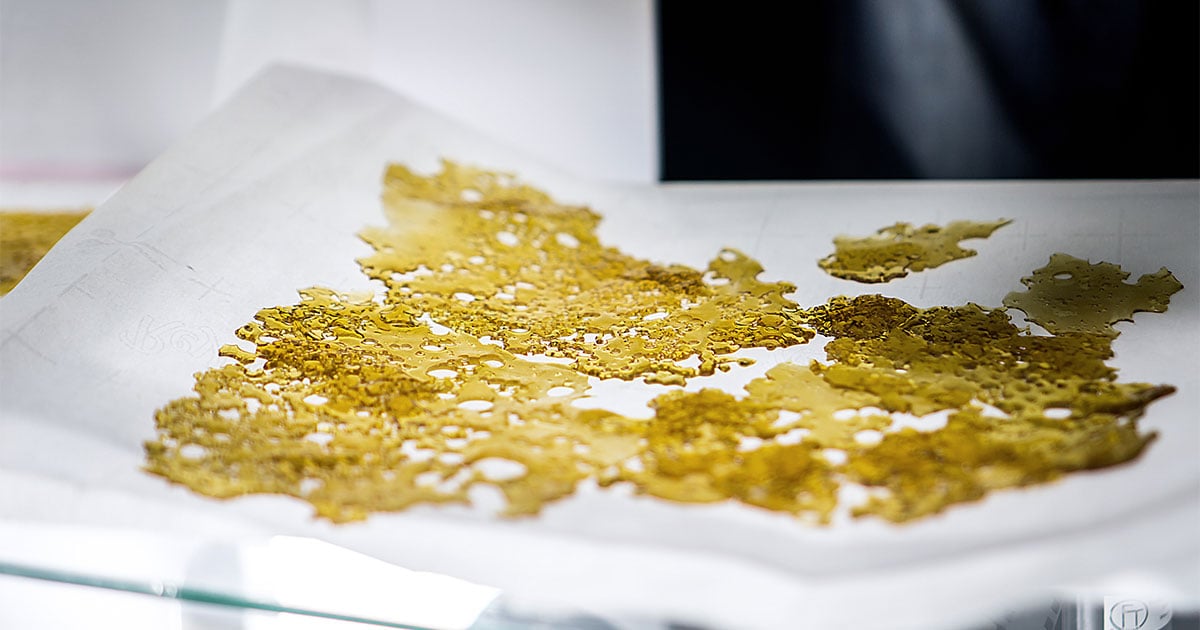
Color remediation technology using a color remediation cartridge (CRC) in your workflow can significantly improve the color and clarity of any quality oil. Whether you have aged or low quality biomass, you can lighten its naturally brown hue into a clearer and more yellow oil.
An in-line CRC add-on can mount directly to the frame of your extractor. A variety of filtration media can remove undesirable compounds such as chlorophyll, xanthophyll, lipids, lycopene, carotene, and pheophytins. Filtration media includes activated silica, activated carbon, activated bleaching earth, diatomaceous earth, and more.
Calculating the right ratios of filter materials relative to the biomass is critical in performing an efficient color remediation without reducing the yield. Operators can use a hydraulic press to pack each layer of filter media to create the perfect stack.
Pro tip: Use Media Bros’ CRX and CRY filter media for the best hydrocarbon extraction results.
20. Be Energy Efficient
Cannabis manufacturing can take up a lot of energy through every step of the BHO process. Companies that want to not only save on energy but also do what is best for the environment and climate change can take numerous steps to reduce their consumption of power.
Off-peak energy use
One energy efficient tip is to run extraction systems during off-peak hours when energy prices are at their lowest. Some companies incentivize technicians with higher pay if they can work the graveyard shift. Make sure that you can maintain a balance between the higher hourly pay and the energy savings.
You can plan processing tasks that require low energy use when the energy prices are higher than normal. For instance, you can perform certain activities that do not require electricity such as winterization or filtration during parts of the day when the electricity price is the highest.
Store cheap energy
You can use cheap energy to your advantage. Take care of what you can when the energy prices are low and then use the stored energy throughout the day. For instance, if you need to fill up your air compressor tank, charge devices, and supply any other equipment with energy, you can do so during off-peak hours for later use.
21. Practice Pesticide and Heavy Metal Remediation
Pesticides
Cannabis extracts can contain a wide range of pesticides so it is helpful if an operator knows which type of pesticides are present and they need to remediate from the oil. Since pesticide remediation methods vary on a case by case basis, it is important to consider your needs and the right decontamination method. Pesticide removal can occur using a variety of methods:
- Flash chromatography: This method is widely used in pharmaceuticals and chemical manufacturing to remove harmful chemicals.
- Glass reactor: Most pesticides are water soluble. Processors can run their crude extract through a glass reactor to remove any water-soluble pesticides.
Heavy metals
In terms of heavy metal remediation of BHO extracts, operators must identify which types of heavy metals need to be removed first. Generally, extraction technicians use a mix of silica, bentonite clay, and activated alumina in the appropriate ratios for the volume of biomass that needs heavy metal remediation.
22. Prevent Mold and Microbial Growth Throughout the Workflow
Irradiation
Careless handling and improper storage of cannabis extracts can make the products susceptible to a variety of contaminants. Some processors use irradiation technology to decontaminate the plant material before they use the biomass during the primary extraction. Reducing the initial mold presence can reduce the risk of contaminating the product.
Third-party vendors and others in the food industry already use these methods to reduce the risk of mold contamination And extend the shelf life of the food. Industry leaders who use these technologies report that irradiation does not degrade the cannabinoids and terpenes in the plant material.
Desiccant packs and containers
Desiccant packs inside the storage containers can maintain an optimal relative humidity between 62 to 65% to keep the plant material fresh and avoid excessive moisture that can lead to mold growth. Some processors use breathable containers to ensure the material gets proper airflow in storage.
Analytical testing
An increasing number of processors are preparing samples of their input material to perform analytical testing for yeast and mold and other contaminants. Contracting an independent analytical laboratory or performing the tests in-house prevents you from working with contaminated material in the first place.
Proper storage
Processors should store their extracted cannabis in airtight and UV-protected containers in a cool, dry, and dark space. Many producers store their extracts in a commercial freezer, preserving their freshness for up to one year. Ensure that there are no major temperature fluctuations in these storage freezers. A smart lock on the freezer can optimize storage.
23. Clean and Maintain Your Equipment and Workspace
The best extraction systems can eventually fail if they are not properly maintained and cleaned. Regular cleaning and maintenance of your closed-loop systems can extend the longevity and maintain a consistent production rate for years to come. Being familiar with every component of your system can help you determine when one needs repairs.
Follow manufacturer guidelines
Follow the manufacturer’s recommendations for cleaning and maintaining your BHO extractor and establish a maintenance schedule based on their guidelines. Regular maintenance can reduce the production issues and bottlenecks such as clogging, low yields, leaks, and other mechanical issues. Some producers recommend cleaning between runs of two different types of strains, such as CBD-rich strains and high THC strains.
Keep spare parts readily available
One of the most important parts of caring for your system is having additional parts and supplies available or knowing where to get them. Certain parts may need faster replacement than others. Having these spare parts around can reduce the need to order, ship, and wait for the product to get here. Instead, you have it ready to go and you can continue your runs without long delays.
24. Consider Industry Trends and Developments
What happens outside of your extraction facility is just as important as what happens inside. Whether there are changing regulations for the extraction market or new industry trends making waves, processors must be on top of the latest developments in research, regulations, technology, and consumer trends to stay ahead of the competition.
Stay up to date by reading industry publications and attending local and national industry events. You can be the first to see and hear about the latest BHO technologies and servicesI can elevate your business. Knowing where the market is right now and where it is going can help you focus or expand your product line to meet the current and future demand.
Luna Technologies: Level Up With Automated BHO Systems
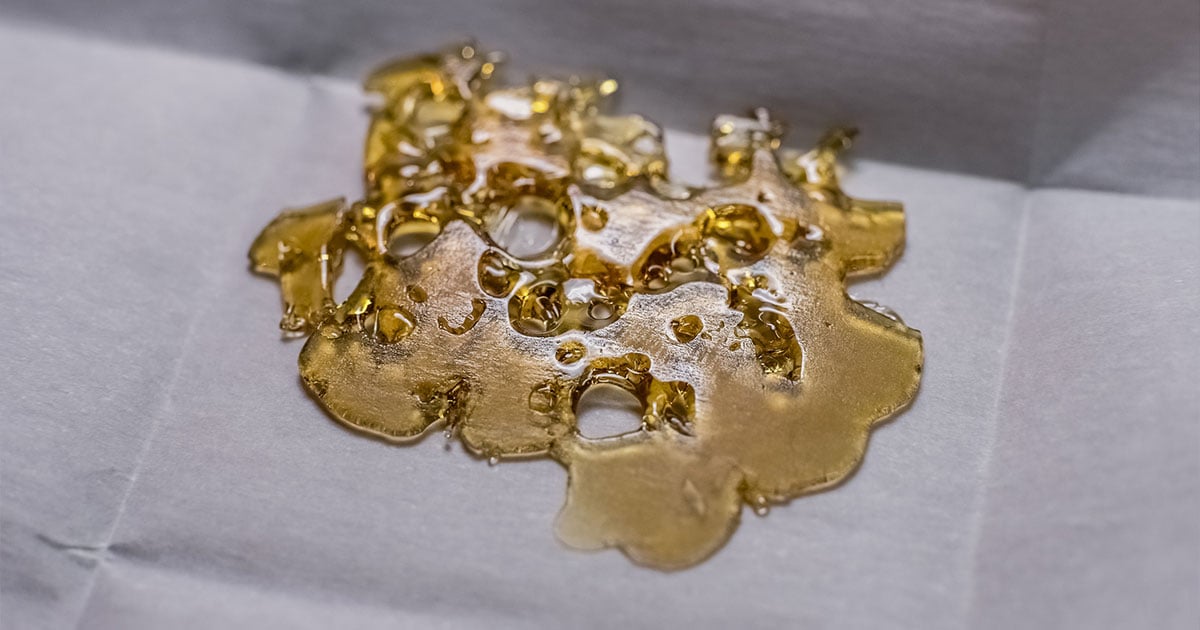
Luna Technologies is on the cutting edge of light hydrocarbon extraction technology. Our automated IO Extractor pushes the envelope of throughput and quality. Create the best full-spectrum extracts and expand your product line to attract any type of customer lifestyle.
Pre-programmed recipes allow the extractor to maintain and monitor optimal temperatures and pressures for your desired product. Handle a variety of biomass from trim to high-quality flowers. Set your recipes to create live resin, sauce, diamonds, shatter, and so much more.
The IO Extractor’s features include:
- Fully automated
- GMP compliant datalogging
- CRN/CSA approved
- Peer-reviewed in every legal cannabis state
- On-site commissioning and training
- Remote troubleshooting
- Dedicated support portal
IO Extractor’s benefits include:
- Reduce labor costs: Automation virtually eliminates extensive training compared to systems with manual controls.
- Eliminate technician error: Our automated extractor monitors pressures and temperatures hundreds of times per second to create the pre-programmed recipes.
- Scale up capacity: Our IO extractor can process 18 pounds of dried biomass or 25 pounds of fresh frozen biomass per run.
- Speed up run time: Our system has a 50-minute average run time with a 10-minute soak. Going from one run to another can take as little as two minutes.
Visit our contact page to reach out to one of our BHO experts to find out more about our products and services. We are here to help you select the right extraction solution for your business.
